Spongy Moth and Kentucky
ENTFACT-425: European Gypsy Moth | Download PDF
by Jonathan L. Larson, Extension entomologist
University of Kentucky College of Agriculture
Fast Facts
- Spongy moth was formerly known as the “European gypsy moth”, the common name was changed officially in 2022 and “spongy” refers to the appearance of the pest’s egg mass.
- As a caterpillar, spongy moth can feed on hundreds of different species of trees, shrubs, and other plants. Their primary host is the white oak tree, an economically important tree to Kentucky’s logging industry.
- In outbreak years, not only do spongy moths create direct damage to plants, but they also become an annoyance as they defecate all over everything and the hairs on their body can irritate human skin.
- Currently, the spongy moth is not established in Kentucky. The Kentucky Office of the State Entomologist’s branch of the Slow the Spread program monitors for this pest annually to be able to respond to potential invasions and keep this caterpillar out of the state for as long as possible.
Potential Hosts
Spongy moths are known to feed on hundreds of plant species. Oaks are their preferred host, though they will also readily attack other tree types such as apple, birches, lindens, sweetgums, and white pines. In a second tier of preference are black walnuts, eastern hemlocks, redbuds, and maples amongst others. Spongy moth will typically avoid feeding on catalpa, dogwood, ash, and arborvitae amongst other species.
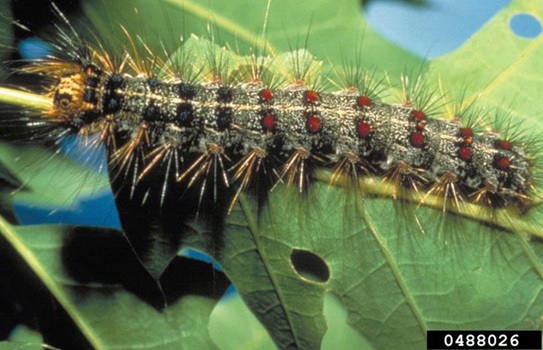
Symptoms and Pest Description
Spongy moth caterpillars can sometimes defoliate trees. In early instars, when the caterpillars are small, they will create small holes in leaves. Once large, they can eat all the of the leaf except for the midrib. The majority of damage is caused by the older caterpillars. Infestations are also noticeable due to large amounts of fecal material, spent pupae, dead adults, and egg masses.
As adults, spongy moths exhibit “sexual dimorphism”, meaning that males and females look considerably different. Female moths are creamy white, around 1.5 inches long, and have thin antennae. Males on the other hand are smaller than females (around an inch long), dark brown, and have feathered antennae. Both sexes have a zigzag pattern on the wings. Behaviorally, males are capable of flight while females are not.
Females will lay a patch of hundreds of eggs, which are then covered with a spongy yellow material. Egg masses have also been described as velvet-like. These egg masses may be laid on nearly any surface, including trees, fence posts, mailboxes, and vehicles.
Emerging caterpillars are small, around 1/16th of an inch long and are dark in color. Males proceed through five instars of development while females have six. Once they have reached the final caterpillar stages, they can be over 3 inches long. Spongy moth caterpillars are slightly hairy and are most noted for the five pairs of blue dots and six pairs of red dots on their back.
When larvae pupate, they are dark brown in color and slightly hairy. Pupae are not inside of thick cocoons like other moths but there may be strands of silk that cover them.
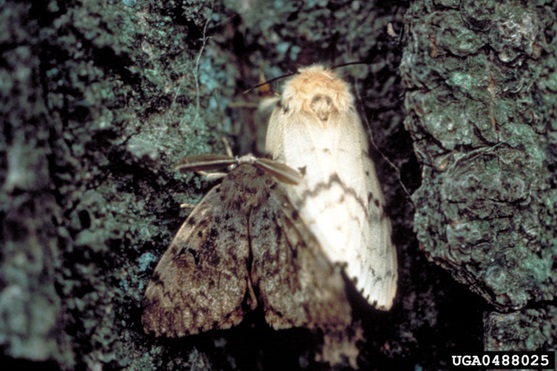
General Life Cycle
Spongy moths have one generation per year in the United States. They overwinter as egg masses, going from one year to the next before hatching. In the spring, around April, new caterpillars will begin to emerge. As they feed, they will develop through multiple instars until June, when they are ready to pupate.
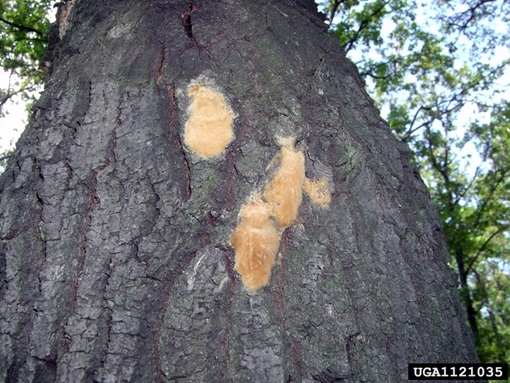
The pupal stage only lasts from June into July. Adult moths emerge from pupae and males will fly to females and mate. After mating, the females will walk to a nearby location to lay the overwintering set of eggs.
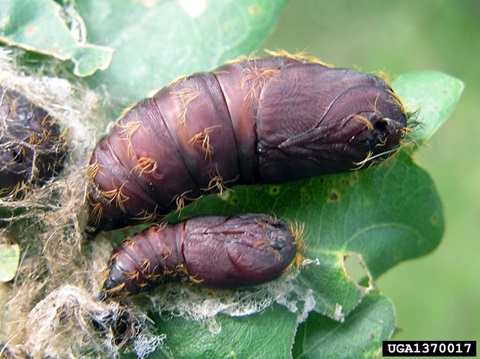
Spongy Moth History and Kentucky
Spongy moth is a historical invasive species, first introduced to the US intentionally around 1869. An amateur entomologist, Etienne Leopold Trouvelot, was attempting to create an American silk industry and intended to use this species in this endeavor. Unfortunately, the insect escaped containment and established itself in Medford, MA, his home community. Over the next 20 years, the caterpillars and moths would spread through Massachusetts, and eventually the first major outbreak occurred in 1889.
Over the next several decades, spongy moth continued to spread through New England and the Mid-Atlantic states. In the 1980-1990’s populations were established in Michigan, Indiana, and Ohio and in the 2000’s, Wisconsin, Illinois, Virginia, and West Virginia were impacted. Across its range, the caterpillar is responsible for millions of acres of defoliated trees and millions of dollars in damage.
Currently, spongy moth is not established in the state of Kentucky. However, active surveillance occurs each year to help monitor possible incursions from border states. This is a part of the national Slow the Spread program, which aims to reduce the speed at which spongy moth spreads in the United States.
In Kentucky, thousands of spongy moth traps are deployed between May and August to monitor for flying male moths. Sometimes referred to as delta traps or triangle traps, these are bright orange and green 3-Dimensional traps. Inside, a small rope is coated with pheromone that smells like a female moth. Surrounding the lure, the trap is coated in sticky glue to capture any insects that wander inside.
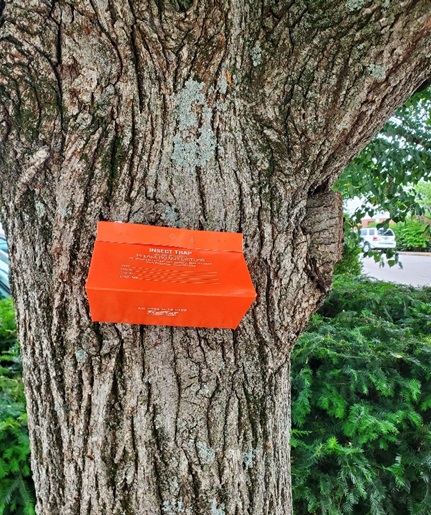
Despite not being established in Kentucky, there are dozens to hundreds of male spongy moths captured in the state every year. These males likely are brought in by winds or through flight from surrounding states. When males are caught, the Kentucky Office of the State Entomologist will respond with more traps in the area to determine if an infestation has arisen or to clear the area of suspicion. In other states with larger infestations, more widespread management measures are taken, including banding trees with traps and aerial applications of a specialized product to kill spongy moth larvae.
There have been four times that a heavier response was needed from Kentucky. These involved larger scale discoveries in Jefferson County in 1985, Carrol and Fleming Counties in 1994, and Campbell County in 2007. These highlight the need for continued vigilance of this pest in Kentucky.
Impact of Spongy Moth on Kentucky
Kentucky’s forests are dominated by oak trees, the primary food source for spongy moths. There is the potential for heavy deforestation across much of the eastern half of the state, impacting trade, recreation, and wildlife, not to mention cities and towns and the trees that grow there.

Economically, Kentucky wood products have a direct impact of $13.5 billion and over 25,000 jobs are associated with timber. Further, the industry had an indirect impact of $4.5 billion. Spongy moth could directly harm these numbers and there could be consequences for movement of wood products if quarantines were put into place to prevent spread from Kentucky to other states.
Further, spongy moths impact the enjoyment of being outdoors. In outbreak years, the billions of caterpillars present produce untold amounts of fecal material. Residents of the northeast report that it sounds like continual rain as the droppings fall to the forest floor and that the annoyance can drive people away from parks and recreational areas. Spongy moth caterpillars can also fall from host trees and may end up in people’s clothing or pressed against their skin. This can result in a skin reaction due to the hairs on the caterpillar. The itchy, raised welts that look like a blister can be very uncomfortable.
How to Help
The general public can help to prevent spongy moth in the state through a variety of ways. The simplest is to not disturb pheromone traps that are used for monitoring. Traps have been found ripped from trees, shot, or otherwise tampered with, reducing the efficacy of the monitoring project.
If you find a suspect caterpillar or moth, you can reach out to the Department of Entomology and the Office of the State Entomologist by emailing reportapest@uky.edu. Be sure to include clear and crisp photographs of the suspect insect as well as detailing the site and the county in which the problem was discovered.
There are pests sometimes confused for spongy moth, including Eastern tent caterpillar and fall webworm. These caterpillars are active at slightly different times of year than spongy moth, tend to be hairier, and construct silken shelters not associated with spongy moth.
Finally, checking wood products, vehicles, and other items for eggs or caterpillars (especially if travelling to infested areas) can prevent the transport of spongy moth back to Kentucky. Most spread of invasive pests like this is aided by human dispersal. Make sure you don’t help this hungry, hungry caterpillar get a toehold in the state!
Citizen Science Opportunities
Interested individuals can further contribute to spongy moth prevention by becoming a citizen scientist. When volunteering as a citizen scientist, you are contributing directly to helping see what pests live where in Kentucky. Specifically with spongy moth, volunteers would be placing pheromone traps out to try and capture male moths. This project is called Kentucky Keepers and in addition to spongy moth surveillance, there are opportunities to monitor spotted lanternfly and tree of heaven.
There’s no experience necessary to apply to Kentucky Keepers. Once your application is accepted, you will be contacted, and further information will be provided based on which surveys you indicated an interest in. Volunteers will need to download an app, Survey123, onto a smartphone or tablet, in order to contribute site location and photos.
Pheromone traps will be distributed in the spring of the year and are usually sent to a county Extension office for pickup. Links to YouTube videos on how to place the trap and log its location are provided as well. No formal training will be needed. Traps must be deployed by June 15th and are usually collected by mid-August.
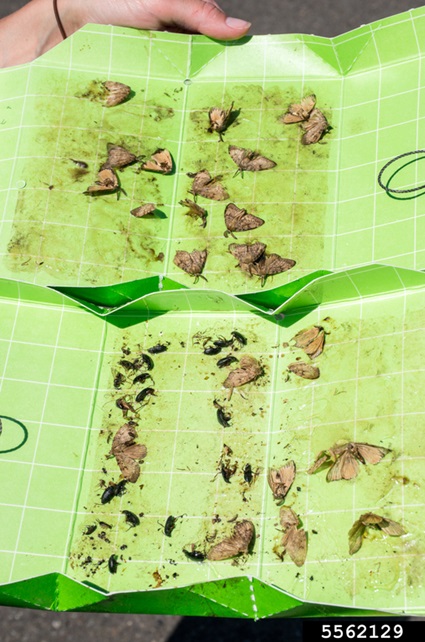
Individuals may volunteer, though groups have participated (Cub Scouts, garden clubs, and Extension volunteers for example). The Kentucky Keepers have expanded surveillance in the state and contribute directly to the Slow the Spread program. Volunteers have captured moths in counties that were otherwise not being monitored. If you would like to volunteer, please go to https://ose-uky-edu.hub.arcgis.com/pages/citizen-scientist-application-form.
Issued: 5/96
Revised 12/23
CAUTION! Pesticide recommendations in this publication are registered for use in Kentucky, USA ONLY! The use of some products may not be legal in your state or country. Please check with your local county agent or regulatory official before using any pesticide mentioned in this publication.
Of course, ALWAYS READ AND FOLLOW LABEL DIRECTIONS FOR SAFE USE OF ANY PESTICIDE!
